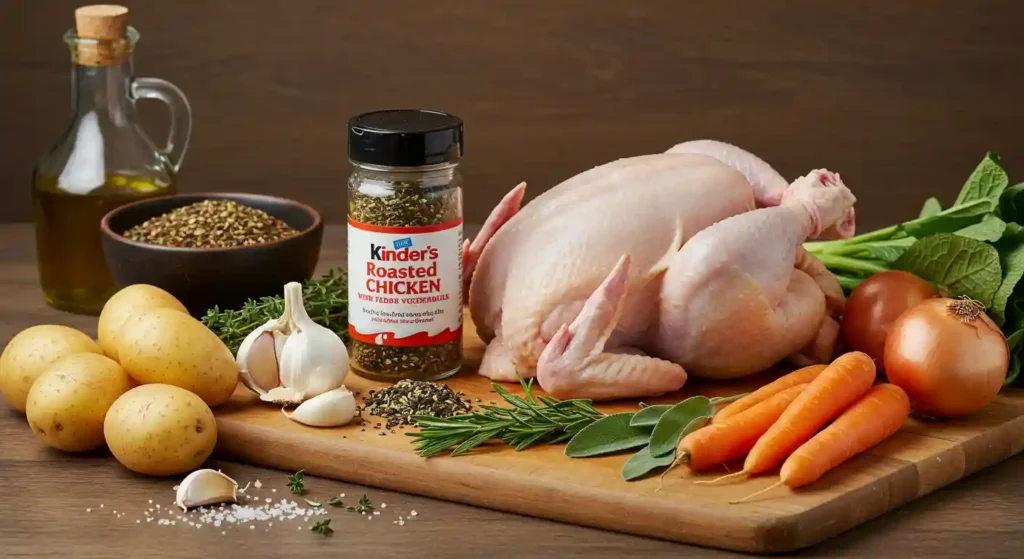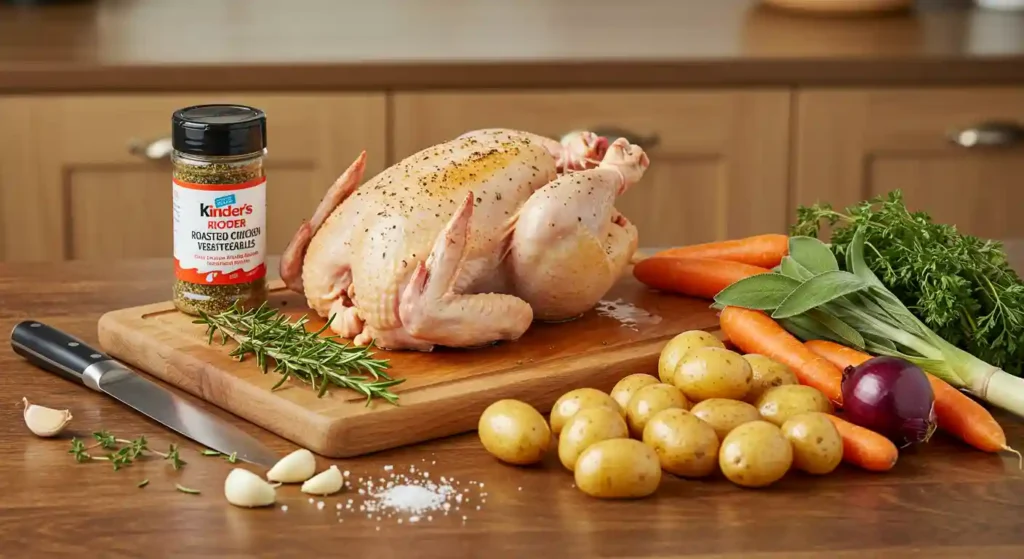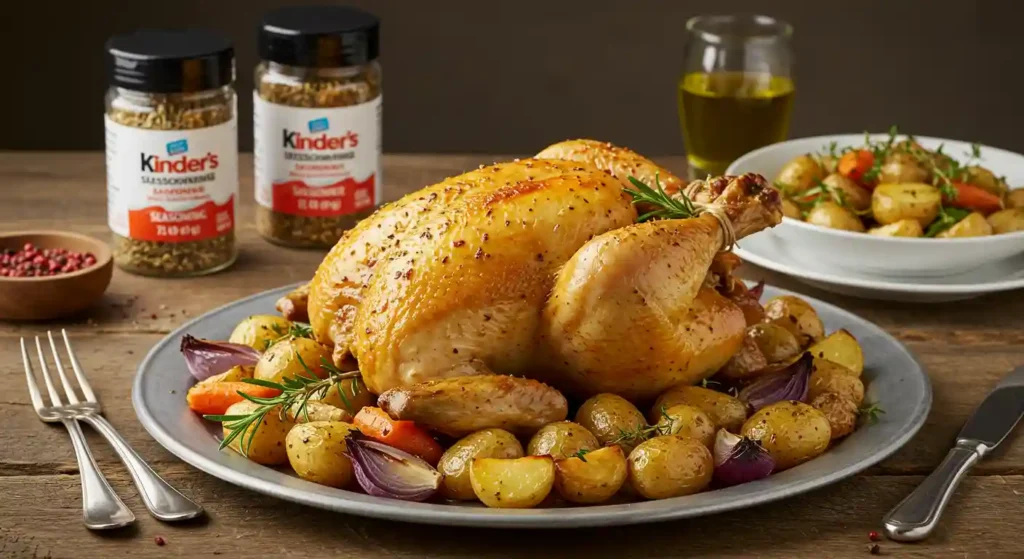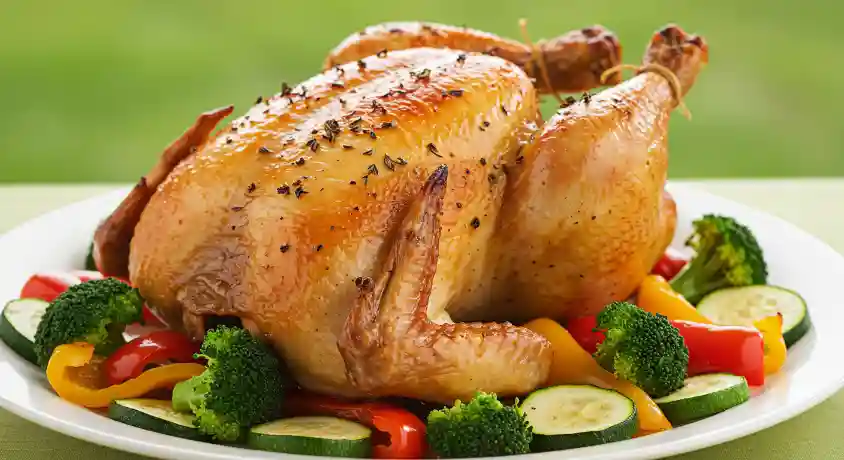The Secret to Perfect Roasting
There’s something undeniably comforting about the smell of a perfectly roast chicken filling your home. It’s a dish that has stood the test of time, gracing family tables for generations. Whether it’s a weeknight dinner or a festive family gathering, a well-cooked roast chicken is the centerpiece of any meal. This dish is beloved for its simplicity, flavor, and the ease with which it can transform an ordinary meal into something extraordinary.
Roasting chicken has deep cultural roots across the world, with every region offering its own unique twist. From the French poulet rôti to the American classic roast chicken with potatoes and vegetables, the method of roasting has evolved through centuries. The concept of cooking meats over an open fire or in a hot oven has been practiced since ancient times, providing not only a delicious flavor but a simple, yet sophisticated cooking technique.
For me, roast chicken holds a special place in my heart. I recall family dinners growing up, where the kitchen would fill with the tantalizing aroma of roasting chicken, my mom’s secret seasoning filling the air. It’s a dish that brings family together—comforting, warm, and satisfying.
Beyond its delicious flavor, roast chicken offers health benefits. Compared to fried options, roasting retains less fat, making it a healthier choice while still ensuring juicy, tender meat. This recipe ensures that you’ll enjoy a flavorful, healthier meal that brings both nourishment and comfort.
Table of Contents
Ingredients for the Perfect Roast Chicken
To create the most delicious, juicy, and flavorful roast chicken, here’s a comprehensive list of ingredients you’ll need:
Main Ingredients:
- Whole Chicken (about 4-5 lbs): A fresh, high-quality roast chicken is essential. Look for free-range or organic chicken for better flavor and texture.
- Olive Oil (or Butter): 3-4 tablespoons of olive oil will keep the chicken moist and crisp the skin. Alternatively, you can use unsalted butter for a richer taste.
- Garlic (4-5 cloves): Fresh garlic cloves provide a fragrant aroma and rich flavor that infuses the chicken while it roasts.
- Fresh Herbs (Rosemary, Thyme, and Sage): A combination of fresh herbs enhances the chicken’s taste, giving it a fragrant, earthy flavor.
- Lemon (1 whole): Lemon adds a subtle citrus kick and helps balance the richness of the chicken.
- Salt (1-2 teaspoons): Salt is key for seasoning. For the best flavor, use kosher salt or sea salt.
- Freshly Ground Black Pepper: To taste, black pepper brings the perfect hint of spice.
- Onion (1 large): Halved onion adds sweetness and depth to the flavor profile.
- Carrots and Potatoes: These vegetables are great for roasting alongside the chicken, absorbing all the savory juices as they cook.
Ingredient Substitutions:

- Dairy-Free Option: If you prefer a dairy-free recipe, simply swap the butter for olive oil or coconut oil. This keeps the dish light while still ensuring the chicken stays moist.
- Gluten-Free: This recipe is naturally gluten-free! No flour is needed, making it safe for anyone with gluten sensitivities.
- Plant-Based Alternatives: For a plant-based option, you could experiment with roasting a whole cauliflower instead of chicken. Season with similar herbs and spices for a hearty, vegetable-based version.
Tips for Choosing the Best Ingredients:
- Dairy-Free Option: If you prefer a dairy-free recipe, simply swap the butter for olive oil or coconut oil. This keeps the dish light while still ensuring the chicken stays moist.
- Gluten-Free: This recipe is naturally gluten-free! No flour is needed, making it safe for anyone with gluten sensitivities.
- Plant-Based Alternatives: For a plant-based option, you could experiment with roasting a whole cauliflower instead of chicken. Season with similar herbs and spices for a hearty, vegetable-based version
By using the best ingredients, you’re guaranteed to create a roast chicken that is full of flavor, tender, and utterly delicious!
Instructions for Perfect Roast Chicken with Vegetables
Roasting the perfect chicken is a combination of technique, patience, and a little love. As we walk through the steps, take your time to ensure each one is done with care. The result will be a juicy, golden, and flavorful chicken that’s the perfect centerpiece for any meal. Here’s your step-by-step guide to mastering the art of roasting chicken.

Step 1: Preheat the Oven and Prepare the Roasting Pan
First, preheat your oven to 425°F (220°C). This high temperature ensures that your chicken cooks evenly and develops that beautifully crispy skin. While the oven is heating up, get your roasting pan ready. You’ll want a sturdy pan large enough to comfortably fit the chicken with some room for vegetables around it. I recommend using a rimmed baking sheet or a cast iron skillet for even heat distribution.
Step 2: Prepare the Chicken
First, remove the chicken from the packaging and gently pat it dry with paper towels. Drying the skin is key to achieving that crispy golden finish. Any moisture left on the chicken will steam it rather than roast it, so be thorough.
Next, remove the giblets from inside the cavity (if included). You can discard them or save them for making stock later. Now, take a whole lemon and cut it in half. Place both halves inside the chicken’s cavity. The lemon will infuse the chicken with a subtle citrus flavor and keep the meat moist during roasting.
Step 3: Season the Chicken
This is where the magic happens! Seasoning your chicken is the key to building layers of flavor. Rub the chicken generously with 3-4 tablespoons of olive oil (or melted butter) all over its skin. Make sure every part of the chicken is covered – the breast, thighs, and even under the wings.
Now, sprinkle kosher salt and freshly ground black pepper all over the chicken. Don’t be shy! You want a good, even coating of salt to enhance the flavor of the meat. Then, grab your fresh herbs (rosemary, thyme, and sage), and stuff a few sprigs into the chicken’s cavity along with the lemon. Rub the remaining herbs on the outside of the chicken to ensure the flavors are infused in every bite.
For extra flavor, crush a few garlic cloves and place them in the pan around the chicken. The garlic will roast and perfume the chicken with its rich, savory aroma.
Step 4: Prepare the Vegetables
While the chicken is being seasoned, it’s time to prepare the vegetables that will cook alongside it. Carrots, onions, and potatoes work wonderfully in this dish. Cut the potatoes into chunks, slice the carrots into thick rounds, and halve the onion. Toss them with a bit of olive oil, salt, and pepper, then place them around the chicken in the roasting pan. These vegetables will soak up the delicious juices from the chicken as it roasts, creating a savory side dish that’s just as irresistible as the chicken itself.
Step 5: Roast the Chicken
Now comes the crucial part: roasting. Place your pan in the oven, making sure the chicken is positioned breast side up. Roast for about 1 hour and 15 minutes to 1 hour and 30 minutes (depending on the size of your chicken). As a general rule, you want to roast for about 20 minutes per pound of chicken. So, if your chicken weighs 4 pounds, roast it for about 1 hour and 20 minutes. Tip: For the crispiest skin, you can roast the chicken at a higher temperature, like 425°F for the first 15 minutes, and then lower it to 375°F for the remainder of the cook time.
Step 6: Check for Doneness
After the recommended cooking time, check the chicken’s internal temperature by inserting a meat thermometer into the thickest part of the thigh (avoiding the bone). It should read 165°F (74°C) to confirm that the chicken is fully cooked. If you don’t have a thermometer, you can also check by cutting between the leg and the body; the juices should run clear, not pink.
Step 7: Rest the Chicken
Once your chicken is done roasting, remove it from the oven and let it rest for about 10-15 minutes. This resting period is crucial to allow the juices to redistribute throughout the meat. Cutting into it immediately would cause all the juices to run out, leaving you with dry chicken. Tip: Cover the chicken loosely with foil while it rests to keep it warm.

Step 8: Carve and Serve
Once the chicken has rested, it’s ready to be carved. Start by removing the legs and thighs, then slice the breast meat against the grain to ensure tender, juicy pieces.. Begin by removing the legs and thighs, then slice the breast meat against the grain for tender, juicy pieces. Serve the chicken alongside the roasted vegetables, which should be tender and infused with all the delicious flavors from the chicken.
Expert Tips for Perfect Roast Chicken:
- Achieving Crispy Skin: Make sure the chicken is completely dry before seasoning, and roast it at a high temperature. If you like extra crispy skin, you can broil the chicken for the last 5 minutes of cooking.
- Resting Time: Be sure to allow the chicken to rest! This crucial step helps retain its juices, keeping the meat juicy and tender.
- Roasting Time: The general rule is 20 minutes per pound of chicken, but it’s always best to check the internal temperature to be sure.
- Vegetables: Feel free to swap in different vegetables like parsnips, sweet potatoes, or garlic cloves. The key is to have them cut into similar-sized pieces for even roasting.
With these steps, you’ll achieve the perfect roast chicken with vegetables every time—crispy on the outside, juicy and tender on the inside, and packed with incredible flavor! Enjoy your meal with family and friends, and savor the rewards of a beautifully cooked dish.
Tips & Variations for the Perfect Roast Chicken
Dietary Adjustments:
If you’re following a specific diet, there are several easy adjustments you can make to this roast chicken recipe:
- Low-Carb or Keto-Friendly: For a low-carb version, skip the starchy vegetables like potatoes and carrots. Instead, roast cauliflower, zucchini, or broccoli alongside the chicken. These vegetables are low in carbs and will still soak up all the delicious chicken juices.
- Paleo-Friendly: This recipe is naturally compatible with a paleo diet—just ensure that you’re using ghee or coconut oil instead of butter or olive oil. Stick to fresh, unprocessed herbs and spices for seasoning.
- Gluten-Free: This recipe is already gluten-free! No modifications are needed, making it perfect for those with gluten sensitivities.
- Dairy-Free: Replace the butter with olive oil, coconut oil, or avocado oil for a dairy-free alternative. These oils will still give the chicken a beautiful crispy skin and keep it moist.
Flavor Enhancements:
Looking to add a bit of flair to your roast chicken? Here are a few ways to elevate the flavor:
- Herb & Spice Rubs: Experiment with different spice rubs, such as a paprika, cumin, and garlic powder blend for a smoky, slightly spicy kick. Or go for a Mediterranean flavor by using oregano, lemon zest, and rosemary.
- Citrus Zest: For an extra burst of freshness, add orange or lime zest to the chicken’s seasoning mix, or even stuff the chicken with a whole lemon, orange, or lime in addition to the traditional lemon. This will infuse a sweet and zesty flavor that complements the richness of the chicken.
- Infused Oil or Butter: Try brushing the chicken with an herb-infused olive oil (rosemary, thyme, and garlic) or citrus butter to add another layer of flavor.
Serving Suggestions:
Pair your perfect roast chicken with sides that complement its flavors:
- Roasted Vegetables: Serve with an array of roasted vegetables like brussels sprouts, parsnips, or sweet potatoes. The caramelization from roasting will add sweetness and depth to the meal.
- Mashed Potatoes: A classic, creamy side that pairs wonderfully with roast chicken. Try a twist by adding roasted garlic or parmesan for extra flavor.
- Fresh Salad: A crisp, refreshing salad made with mixed greens, cucumber, and a light lemon vinaigrette will balance the richness of the chicken.
- Gravy or Sauce: If you like a bit of sauce with your chicken, try a simple pan gravy made from the drippings or a garlic-herb aioli for dipping.
With these tips and variations, you can make the roast chicken recipe your own, adjusting the flavors and sides to suit your dietary needs or taste preferences. Enjoy creating your perfect version of this classic dish!
Nutritional Information for Roast Chicken with Vegetables

Caloric and Macronutrient Breakdown:
A serving of roast chicken with vegetables (approximately 1/4 of a whole chicken, with roasted potatoes, carrots, and onions) provides a balanced and satisfying meal. Here’s an approximate breakdown of the nutritional content per serving
- Calories: 400–500 calories
- Protein: 35–40 grams
- Fat: 20–25 grams
- Saturated Fat: 4–6 grams
- Carbohydrates: 20–30 grams
- Fiber: 4–6 grams
- Sugars: 4–7 grams
- Sodium: 500–600 mg
Note: The nutritional values can vary depending on the size of the chicken, the amount of oil or butter used, and the specific vegetables selected.
Health Benefits of Ingredients:
- Chicken:
- Chicken is a high-quality source of protein, which is essential for muscle repair, immune function, and overall body maintenance. A serving of roast chicken provides around 30–35 grams of protein, making it a great option for anyone looking to meet their daily protein needs. Additionally, chicken contains B vitamins, particularly niacin and vitamin B6, which are important for energy metabolism and maintaining healthy brain function.
- Herbs (Rosemary, Thyme, Sage):
- Fresh herbs like rosemary, thyme, and sage aren’t just for flavor—they also offer a variety of health benefits. Rosemary is rich in antioxidants, which help protect cells from damage by free radicals. It also has anti-inflammatory properties that support overall wellness. Thyme is packed with vitamin C, which boosts the immune system, while sage contains compounds that may promote digestion and cognitive function. Incorporating fresh herbs into your diet is a great way to add flavor without adding excess calories or sodium.
- Vegetables (Carrots, Potatoes, Onions):
- The vegetables accompanying the chicken provide essential vitamins, minerals, and fiber. Carrots are high in beta-carotene (a precursor to vitamin A), which supports eye health and immune function. Potatoes are a good source of vitamin C, potassium, and fiber, particularly when you leave the skins on. Onions offer antioxidants and anti-inflammatory benefits, and their natural sweetness complements the savory chicken.
Together, these ingredients create a well-balanced, nutrient-dense meal that supports overall health while delivering a satisfying combination of protein, healthy fats, and fiber. The inclusion of fresh vegetables and herbs further enhances the dish’s health benefits, making it a nutritious choice for any meal.
Common Mistakes & Fixes for Perfect Roast Chicken
Mistakes in Preparation:
- Under-Seasoning the Chicken: One of the most common mistakes when roasting chicken is not seasoning it enough. A bland chicken won’t deliver the full flavor potential, leaving you with a disappointing result.
- Fix: Be generous with your seasoning! Use enough salt and pepper to cover the skin and the inside cavity. Don’t forget to season the vegetables as well, and use fresh herbs for a more vibrant flavor. Consider rubbing the chicken with a spice blend or citrus zest to enhance the flavor profile.
- Roasting at the Wrong Temperature: Roasting chicken at too low of a temperature can result in rubbery skin and dry meat, while cooking at too high a temperature may lead to burnt skin and undercooked meat inside.
- Fix: Preheat your oven to 425°F (220°C) to ensure the skin crisps up nicely. After 15 minutes, you can reduce the temperature to 375°F (190°C) to cook the chicken through. Use a meat thermometer to ensure it reaches 165°F (74°C) in the thickest part of the thigh.
Fixing Flavor Issues:
- Dry Chicken: Dry chicken can occur if the bird is overcooked or hasn’t been basted properly during the cooking process.
- Fix: To prevent dry chicken, baste the bird every 30 minutes with the pan drippings, or brush it with olive oil or melted butter. If the chicken is already dry, you can drizzle it with a bit of chicken stock or a lemon-based sauce to add moisture.
- Unbalanced Flavor: Sometimes the chicken may taste a bit flat, especially if the seasoning wasn’t properly balanced.
- Fix: Taste your chicken before serving and adjust the seasoning. A little extra salt or a squeeze of lemon can elevate the flavor. If the chicken is too salty, try serving it with a side of mashed potatoes or a mild, creamy sauce to balance out the saltiness.
Ensuring Proper Roasting:
- Uneven Cooking: If the chicken isn’t cooked evenly, parts of it may be overdone while others are undercooked.
- Fix: Make sure your chicken is placed breast side up and is not crowded in the roasting pan. If you’re roasting vegetables alongside the chicken, ensure they are cut into similar sizes and are spread evenly around the chicken. Also, consider rotating the chicken halfway through cooking to ensure it roasts evenly.
- Not Letting the Chicken Rest: Cutting into the chicken right after it comes out of the oven can lead to all the juices running out, leaving you with dry meat.
- Fix: Allow the chicken to rest for 10-15 minutes after roasting. This allows the juices to redistribute, making sure every bite is tender and juicy.
By following these simple fixes, you can avoid common mistakes and achieve a perfectly roasted chicken every time!
FAQs for Perfect Roast Chicken with Vegetables
How to Store the Roasted Chicken?
To store leftovers from your roast chicken, follow these simple tips:
- In the Refrigerator: Allow the chicken to cool down to room temperature before storing. Once cooled, place it in an airtight container or tightly wrap it in plastic wrap or aluminum foil. Leftover roast chicken can be stored in the fridge for 3 to 4 days. To reheat, cover it with foil and warm it in a 350°F (175°C) oven for about 10-15 minutes until heated through.
- Freezing: If you have a lot of leftovers, freezing is a great option. First, remove any bones and slice the meat. Place the chicken in an airtight freezer bag or container. IIt can be stored in the freezer for up to 2-3 months for long-term preservation. When you’re ready to eat, defrost it in the fridge overnight and reheat.
Can I Prepare It in Advance?
Yes! Some steps can be prepped ahead of time for a quicker meal on the day you want to serve it:
- Marinating: While the roast chicken recipe doesn’t require marinating, you can season the chicken a few hours or even overnight before roasting. This helps the flavors to fully penetrate the meat.. Simply rub the chicken with oil, herbs, salt, and pepper, then cover and refrigerate until ready to roast.
- Chopping Vegetables: You can prepare the vegetables (potatoes, carrots, onions) the day before. Store them in an airtight container in the fridge, so they’re ready to go when it’s time to roast the chicken.
- Complete Preparation: Roasting the chicken in advance and reheating it is also an option, but fresh roasted chicken is always ideal for the best flavor and texture.
What Are the Best Additions or Variations?
For those who want to customize their roast chicken, here are a few additions and variations to consider:
- Garlic Butter: For extra richness, brush the chicken with garlic butter before roasting. Combine melted butter, minced garlic, and herbs like rosemary and thyme, and coat the chicken with the mixture for a deliciously savory finish.
- Rosemary & Lemon: Add extra rosemary and lemon slices inside the cavity of the chicken to infuse even more aroma and citrusy brightness into the meat.
- Spice Blends: Try experimenting with different spice blends to change the flavor profile. Cajun seasoning or paprika and cumin can give the chicken a smoky, slightly spicy kick. Za’atar (a Middle Eastern spice blend) adds a fragrant, herby twist.
- Stuffing the Chicken: Add herbs, garlic, onions, or even fruits like apples or oranges inside the chicken’s cavity for a unique flavor boost.
These simple variations can elevate your roast chicken and give you endless flavor possibilities to explore!
Conclusion & Call to Action
This roast chicken with vegetables recipe is the perfect balance of simplicity and flavor, making it a must-try for anyone seeking a hearty, comforting meal. With its crispy skin, tender meat, and savory vegetables, this dish brings warmth and satisfaction to any table. Whether you’re serving it for a family dinner or a special gathering, the versatility and ease of preparation make it a go-to recipe for busy weeknights and cozy weekends alike.
Now it’s your turn to experience the magic of a perfectly roasted chicken! Try this recipe in your kitchen and enjoy the juicy, flavorful results. Don’t forget to share your thoughts and tips in the comments below — I’d love to hear how it turned out and any creative variations you made!
If you’re looking for more delicious ideas to complement your roast chicken, check out some of my other recipes for perfect side dishes and mouthwatering sauces. From creamy mashed potatoes to fresh salads and rich gravies, there’s something for everyone to enjoy. Happy cooking, and I can’t wait to see what you create!


2 thoughts on “Juicy and Tender Kinder’s Roast Chicken”
Comments are closed.